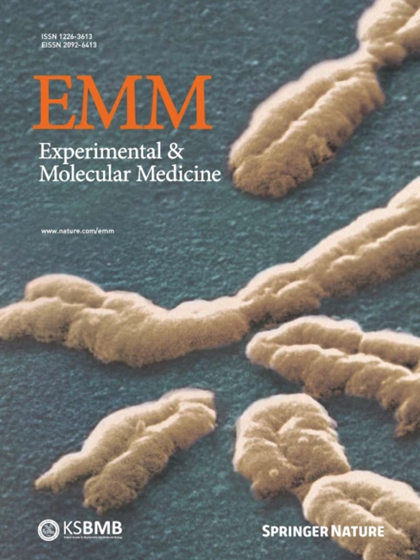鸟嘌呤核苷酸交换因子DOCK5通过MKK3/6和p38信号通路负调控成骨细胞分化和bmp - 2诱导的骨再生。
IF 9.5
2区 医学
Q1 BIOCHEMISTRY & MOLECULAR BIOLOGY
引用次数: 0
摘要
DOCK5是Rac1的鸟嘌呤核苷酸交换因子,与bmp - 2介导的成骨细胞分化有关,但其在成骨和骨再生中的具体作用尚不清楚。本研究利用DOCK5化学抑制剂C21和DOCK5缺陷小鼠研究DOCK5对骨再生的影响。利用骨髓间充质干细胞(BMSCs)和多种动物模型分析成骨细胞分化和骨再生。C21显著增强小鼠MC3T3-E1细胞、人和小鼠骨髓间充质干细胞的成骨细胞分化和矿物质沉积。Dock5基因敲除(KO)小鼠的骨量和矿物质附着率增加,其骨髓间充质干细胞显示出增强的成骨细胞分化。与野生型(WT)小鼠相比,颅骨缺损和异位骨形成模型在Dock5 KO小鼠中显著诱导骨再生。此外,在WT小鼠中,C21对DOCK5的抑制增强了bmp2诱导的皮下异位骨形成。DOCK5抑制诱导骨形成增强的机制可能涉及TAK1对Rac1的抑制,同时伴有BMP2诱导的MKK3/6和p38的激活。这些发现强烈提示DOCK5通过涉及TAK1、MKK3/6和p38的信号通路负调控成骨细胞分化和骨再生,为骨再生的潜在治疗策略提供了新的见解。本文章由计算机程序翻译,如有差异,请以英文原文为准。

The guanine nucleotide exchange factor DOCK5 negatively regulates osteoblast differentiation and BMP2-induced bone regeneration via the MKK3/6 and p38 signaling pathways
DOCK5 (dedicator of cytokinesis 5), a guanine nucleotide exchange factor for Rac1, has been implicated in BMP2-mediated osteoblast differentiation, but its specific role in osteogenesis and bone regeneration remained unclear. This study investigated the effect of DOCK5 on bone regeneration using C21, a DOCK5 chemical inhibitor, and Dock5-deficient mice. Osteoblast differentiation and bone regeneration were analyzed using bone marrow mesenchymal stem cells (BMSCs) and various animal models. C21 significantly enhanced osteoblast differentiation and mineral deposition in mouse MC3T3-E1 cells and in human and mouse BMSCs. Dock5 knockout (KO) mice exhibited increased bone mass and mineral apposition rate, with their BMSCs showing enhanced osteoblast differentiation. Calvarial defect and ectopic bone formation models demonstrated significant induction of bone regeneration in Dock5 KO mice compared to wild-type (WT) mice. Moreover, DOCK5 inhibition by C21 in WT mice enhanced BMP2-induced subcutaneous ectopic bone formation. The mechanism responsible for enhanced bone formation induced by DOCK5 inhibition may involve the suppression of Rac1 under TAK1, accompanied by the activation of MKK3/6 and p38 induced by BMP2. These findings strongly suggest that DOCK5 negatively regulates osteoblast differentiation and bone regeneration through signaling pathways involving TAK1, MKK3/6, and p38, providing new insights into potential therapeutic strategies for bone regeneration. Bone regeneration involves repairing damaged or lost bone by forming new tissue, supported by growth factors like BMP2 (bone morphogenetic protein 2). However, high doses of BMP2 can cause side effects. In this study, researchers found that blocking DOCK5, a protein involved in cell signaling, enhances BMP2’s ability to promote bone growth. They used chemical inhibitors and genetically modified mice to study DOCK5’s role in bone formation, growing bone cells in vitro and testing bone regeneration in vivo. Results showed that inhibiting DOCK5 increased bone growth and mineralization when BMP2 was present. The study suggests that targeting DOCK5 could enhance BMP2’s effects, allowing for lower doses in bone healing and offering a new approach for bone repair therapies. Future research may explore the use of DOCK5 inhibitors in clinical settings. This summary was initially drafted using artificial intelligence, then revised and fact-checked by the author.
求助全文
通过发布文献求助,成功后即可免费获取论文全文。
去求助
来源期刊

Experimental and Molecular Medicine
医学-生化与分子生物学
CiteScore
19.50
自引率
0.80%
发文量
166
审稿时长
3 months
期刊介绍:
Experimental & Molecular Medicine (EMM) stands as Korea's pioneering biochemistry journal, established in 1964 and rejuvenated in 1996 as an Open Access, fully peer-reviewed international journal. Dedicated to advancing translational research and showcasing recent breakthroughs in the biomedical realm, EMM invites submissions encompassing genetic, molecular, and cellular studies of human physiology and diseases. Emphasizing the correlation between experimental and translational research and enhanced clinical benefits, the journal actively encourages contributions employing specific molecular tools. Welcoming studies that bridge basic discoveries with clinical relevance, alongside articles demonstrating clear in vivo significance and novelty, Experimental & Molecular Medicine proudly serves as an open-access, online-only repository of cutting-edge medical research.
 求助内容:
求助内容: 应助结果提醒方式:
应助结果提醒方式:


